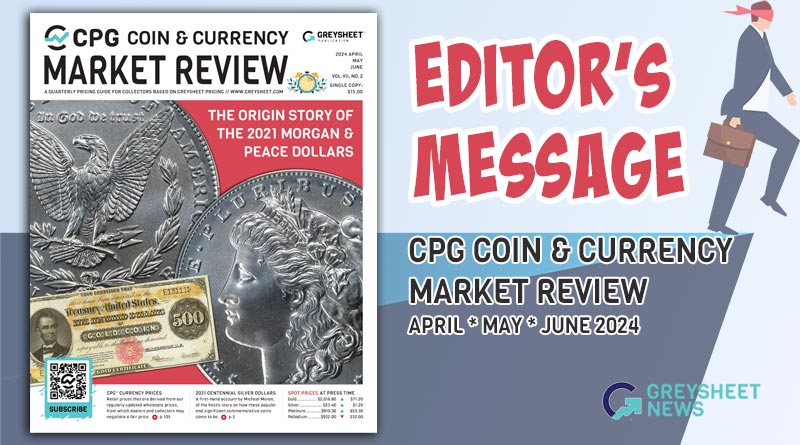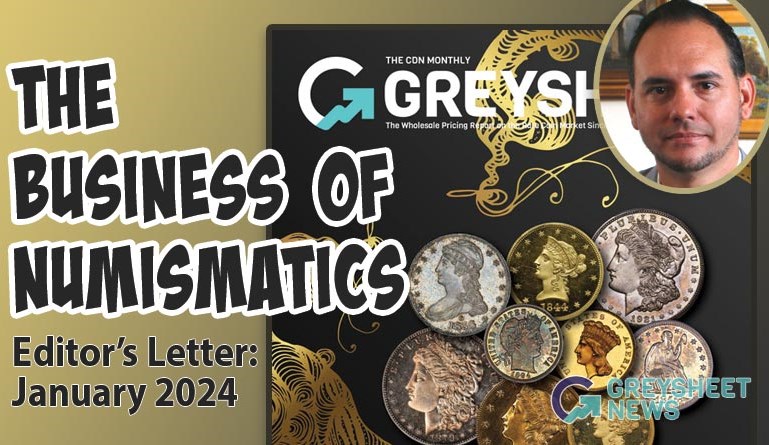By Patrick Ian Perez, Editor
As the season turns to spring and the weather finally begins to warm up in many places, the United States coin market remains mild. Taking a survey of the U.S. auction market so far this year, as I write this in early April, we find that a total of $90,821,018 worth of coins has crossed the auction block. This includes heavily promoted sales held in conjunction with a coin show, such as the Heritage FUN auction, Legend Rare Coin Auctions Regency 30, Heritage February Long Beach, Goldberg Coins Pre-Long Beach, and Stack’s Bowers Baltimore. This also includes weekly or periodic online-only sales including David Lawrence Rare Coins Sunday auctions, Stack’s Bowers Collector’s Choice auctions, and Heritage Weekly U.S. coin auctions.
With regards to recent activity, the Heritage Dallas Signature sale garnered $7,988,127 and the Legend Regency 31 sale held in Las Vegas took in $5,966,973. Not included are other venues at which U.S. coins are sold, the obvious one being eBay. This puts the market on pace for roughly $350 to $400 million in auction sales for the year. There is clearly a good amount of dollars flowing through the coin market, and while the public auction market does not tell the whole story, it has been proven to be a good barometer of overall demand for rare coins. It is my goal to create a “CDN Auction Sales Ticker” to track total auction sales throughout the year, and also enable quick year-over-year comparisons. From a coin-dealer standpoint, auctions represent both competition for the retail customer but also significant opportunity. There has long been debate about who is the bigger buyer in a given auction: dealers or collectors (or their agents). Obviously, there is a price threshold above which most coins are going to collectors because very few dealers can or are willing to stock a $50,000 coin. The opportunity exists where the market needs the support the most: coins in the $100 to $1,000 range, where dealers can sift though the volume of coins that go through the sales and stock nice pieces for inventory that will also yield a fair margin.
Circling back to recent auctions, there certainly has been some newsworthy results. In the Legend Regency 31 sale, a 1927-D Peace dollar graded PCGS MS66+ realized a very strong $176,250, setting the record for the date by a long margin. This was first MS66+ 1927-D to sell at auction, which is a population three coin in this grade. The prior high watermark for this date was $46,000 for a MS66 (no plus) back in 2009. This result provides good insight into the current market. Popular opinion states that prices such as these are driven by the evolution of registry set collecting. While this is mostly true, the buyer is putting significant trust in the certification service to be consistent over a long period of time – working under the assumption that a six- or high-five-figure coin is being held for several years – to keep the population numbers at the top relatively stable.
We are at the point in the coin market where virtually all high-value rare United States coins have been certified at least once. Thus, when a Peace dollar collector looks at the 1927-D in MS66+ and sees that there are three in existence, the price he is willing to pay is inherently contingent on the idea that in five years the population will not be 10. The exception to this is when a coin is judged to be the best of its kind, period. Say, if numismatists were able to examine all three PCGS MS66+ 1927-D Peace dollars side by side; there is a good possibility that one of the three would be the consensus “finest.” In theory, this would be the coin worthy of the record price. This carries over to many modern issues, with Washington quarters, Roosevelt dimes, and Jefferson nickels reaching heights that some scoff at, but if the piece is truly the finest in existence, the price is justified. Dealers and collectors can take comfort, as these trends have also been very prevalent in three other major collectibles markets: sports cards, comic books, and watches. Cards and comics graded 9.8 or 10 (on a scale of 10) are regularly bringing many multiples of the same item in even one grade point lower. Collectors are waking up to the rarity of top-pop pieces.

Download the Greysheet app for access to pricing, news, events and your subscriptions.
Subscribe Now.

Subscribe to Monthly Greysheet for the industry's most respected pricing and to read more articles just like this.
Author: Patrick Ian Perez











